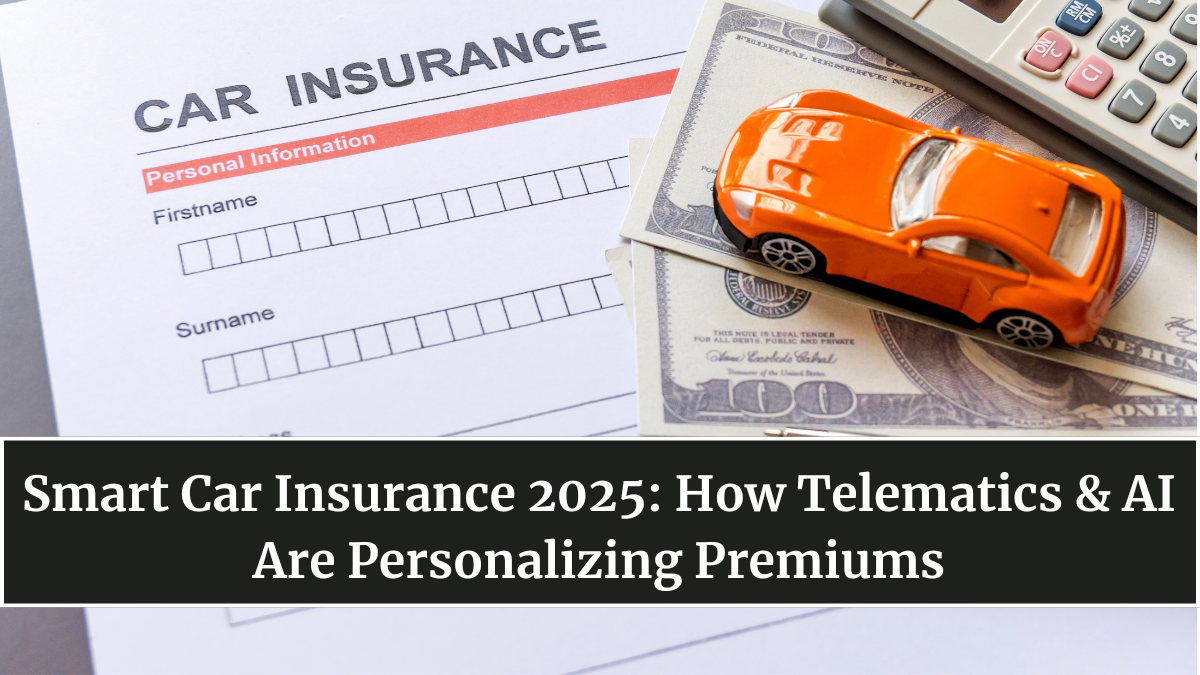Imagine your car insurance adjusting itself automatically — rewarding you for safe driving, alerting you to risks, and even lowering premiums in real time. That’s the promise of Smart Car Insurance 2025, where AI and telematics combine to make auto coverage truly personalized, data-driven, and fair.
The era of flat-rate insurance is fading. In 2025, your car’s sensors, GPS, and AI tools can paint a complete picture of how, when, and where you drive. Insurers are using this insight to calculate risk more accurately, ensuring that careful drivers pay less, while risky driving behavior is flagged instantly — not months later.

How Telematics Is Revolutionizing Car Insurance
Telematics refers to the use of onboard devices and sensors to record driving data such as speed, braking, acceleration, mileage, and even cornering style. These data points are transmitted to insurers in real time or through mobile apps.
AI then processes this data to build a driving behavior profile, enabling insurers to design customized premiums instead of relying on generic demographic averages. This model is often referred to as Usage-Based Insurance (UBI) or Pay-How-You-Drive (PHYD).
Key benefits include:
-
Real-time premium adjustments based on behavior.
-
Rewards or discounts for consistent safe driving.
-
Instant claims assistance in the event of an accident.
-
Better fraud detection using data-backed evidence.
The Role of Artificial Intelligence in Risk Assessment
Artificial intelligence is the brain behind telematics-driven insurance. By analyzing massive amounts of data from millions of vehicles, AI identifies patterns humans might miss.
For example:
-
Detecting subtle signs of fatigue or distraction based on braking intervals.
-
Comparing driver behavior under different weather or road conditions.
-
Using predictive models to estimate accident probabilities before they happen.
AI systems also streamline claims by analyzing crash data and dashcam footage, enabling near-instant settlements — a major leap from traditional claim cycles that could take weeks.
Global Adoption and Market Trends
By 2025, nearly 45% of all car insurance policies in developed markets have integrated telematics or AI-driven risk assessment tools. Leading insurers such as Allstate, Progressive, and AXA have introduced app-based programs rewarding cautious driving.
In India, companies like HDFC ERGO and Bajaj Allianz have launched telematics-based plans under IRDAI’s “Sandbox” initiative, allowing data-based premium flexibility. Meanwhile, European nations are integrating smart insurance with connected vehicle infrastructure, enabling real-time communication between vehicles and insurers.
This global momentum is shaping an entirely new category — Smart Mobility Insurance — that evolves with each trip you take.
Benefits for Drivers and Insurers
For Drivers:
-
Transparent and fair pricing — no more paying for others’ bad driving.
-
Personalized insights on habits like speeding or hard braking.
-
Accident alerts sent directly to emergency responders.
For Insurers:
-
Better loss prediction and reduced fraudulent claims.
-
Enhanced customer loyalty through gamified reward systems.
-
Lower operational costs through automation and AI-led claims management.
Smart insurance effectively aligns safety with savings — turning responsible driving into financial rewards.
Challenges and Privacy Concerns
While the benefits are enormous, the rise of data-centric insurance brings new challenges:
-
Data Privacy: Continuous monitoring means insurers must safeguard sensitive driving data.
-
User Trust: Some drivers fear excessive surveillance or misuse of personal information.
-
Device Integration: Compatibility issues may arise between different car models and insurance apps.
-
Regulatory Frameworks: Laws are still evolving to define ownership and use of telematics data.
Governments are now mandating data anonymization, consent protocols, and secure cloud systems to protect user rights while allowing innovation to flourish.
The Road Ahead for Smart Insurance
By 2030, car insurance is expected to become fully dynamic — adapting not just to how you drive, but also to where and when. AI will assess factors like weather, traffic density, and even mental fatigue indicators from smart wearables.
Emerging trends include:
-
Instant, AI-approved claims without human intervention.
-
Integration with connected cars and smart city systems.
-
Eco-driving rewards, where drivers using EVs or hybrid modes pay lower premiums.
-
Blockchain-based verification for transparent claims and policy management.
The result will be a frictionless ecosystem where technology, transparency, and trust redefine what insurance truly means.
FAQs
What is Smart Car Insurance?
It’s a new insurance model that uses AI and telematics to analyze real driving behavior and adjust premiums dynamically.
How does telematics work?
A device or smartphone app records driving data — like speed, braking, and mileage — and shares it securely with insurers for real-time analysis.
Do smart insurance systems invade privacy?
Insurers use encrypted and anonymized data. Drivers can opt in and view exactly what data is collected and how it’s used.
What are the benefits for safe drivers?
Safe drivers enjoy lower premiums, instant rewards, and personalized insights for improving road safety.
Will all car insurance become AI-driven?
Yes. By the late 2020s, almost all major insurers will shift toward AI-led, telematics-based systems for fairer and faster risk assessment.
Click here to know more.
